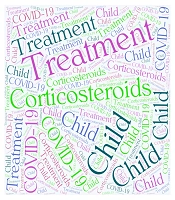Dear editor,
SARS-CoV-2 is a novel beta-coronavirus single-stranded RNA virus with similarities to the middle east respiratory syndrome coronavirus (MERS-CoV) and severe acute respiratory syndrome coronavirus (SARS-CoV). The World Health Organization (WHO) named the disease caused by the SARS-CoV-2 spread in 2019 as COVID-19 that usually manifests with nonspecific mild symptoms such as myalgia, cough, fever, and diarrhea with or without dyspnea. However, severe manifestations, including acute respiratory distress syndrome (ARDS), sepsis, and septic shock, are increasingly reported (1).
It has been shown that in some cases of SARS-CoV-2 infection, an uncontrolled immune response following the hyperactivation of macrophages and monocytes induces a massive release of pro-inflammatory cytokines such as interleukin-2 (IL-2), IL-6, IL-1β, and tumor necrosis factor α (TNFα). This “cytokine storm” can lead to potentially fatal complications such as severe pneumonia, ARDS, and multi-organ failure (2, 3). It was shown that the COVID-19 patients requiring intensive care had higher blood plasma levels of these cytokines (4). Moreover, IL-6 levels were relatively higher in non-survivors than survivors (5). Considering the critical role of cytokine storm in the prognosis of COVID-19, suppression of this inflammatory phenomenon can theoretically reduce COVID-19 morbidity and mortality (6).
Most of the available evidence regarding the use of corticosteroids in patients presenting with ARDS is based on experimental studies on the SARS-CoV and MERS-CoV viruses; however, their results are controversial, and only a few studies have directly investigated the effects of corticosteroids on COVID-19. Theoretically, corticosteroids control inflammatory responses in severe acute respiratory infections by regulating the signaling pathways derived from cell membranes or intracellular mediators, inhibiting the adhesion and action of proinflammatory cytokines, and increasing the production of anti-inflammatory mediators (6). According to an in vitro study, Ciclesonide, an inhaled corticosteroid, exhibited direct antiviral activity against the MERS-CoV and SARS-CoV viruses (7). Another observational study on 84 patients with COVID-19-related ARDS showed a significantly lower mortality rate in the patients treated with methylprednisolone compared with those who received no corticosteroids (8). On the other hand, a meta-analysis involving 5270 subjects with SARS-CoV, SARS-CoV2, or MERS-CoV infections found that treatment with corticosteroids was associated with significantly longer hospital stay (95% CI = 5.26 - 7.37, mean difference (MD) = 6.31) and higher rates of bacterial infections (relative risk (RR) = 2.08, 95% CI = 1.54 - 2.81), hypokalemia (RR = 2.21, 95% CI =1.07 - 4.55), and mortality (RR = 2.11, 95% CI = 1.13 - 3.94) (9). Similarly, Li et al. reviewed 11 studies involving 5249 subjects with coronavirus infections, reporting a significant increase in delayed virus clearance (95% CI = 1.16 - 6.41 days, MD = 3.78 days) and hospitalization duration (95% CI = 5.15-14.18 days, MD = 9.66 days), but no significant reduction was observed in the mortality rate (10). Recently, dexamethasone has been announced as a "lifesaving scientific breakthrough" in the management of COVID-19, reducing the mortality rate by about one-third in patients on ventilators and one-fifth in the patients requiring oxygen (11).
A recent guideline recommends using corticosteroids in patients who suffer from COVID-19 associated with shock and/or cytokine storm before or after the development of ARDS (6). However, according to the latest reports, the WHO is updating treatment guidelines to include dexamethasone or other steroids (11). Based on what was explained, it seems logical to prescribe corticosteroids for patients with COVID-19 related to septic shock and ARDS. These patients are more likely to develop tissue damage following a cytokine storm. Nevertheless, the advantages and disadvantages of corticosteroids should be kept in mind before prescribing them.
